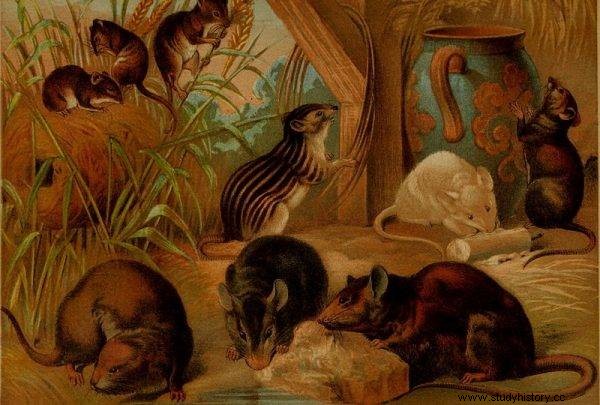How would living in a utopia affect us? John Calhoun decided to find the answer, creating a mouse utopia. The result of his experiment was terrifying.
Utopia is understood, inter alia, as the ideal of a happy society. For most of us, it would be a world where there are no hunger, no wars, no healthcare for everyone, and no problems in everyday life. However, it is worth asking yourself, how would we actually be affected by living in a world without worries and dilemmas? John Calhoun decided to find the answer, creating a mouse utopia.
He was an American ethologist and researcher-behaviorist. His main interests focused on analyzing the behavior of animals (especially rodents) and drawing conclusions from them suggesting how overpopulation may affect the development of our society . He created an experiment, colloquially known as the "mouse utopia", which after four years resulted in a rather terrifying result.
Preparations to create a utopia
The aim of the experiment was to check how living organisms behave in a limited living space. Calhoun chose mice as the object of his research, for which a special cage was built. It was equipped with unlimited access to food, water and materials from which rodents could build nests in special boxes. The temperature was kept constant at 20 degrees. The mice were not in any danger from predators. They also had constant veterinary control, especially in terms of protecting the population against infectious diseases.

John B. Calhoun was an American ethologist and behaviorist researcher.
Thus, ideal (almost utopian) living conditions were created. The only limitation was space. The cage could hold a maximum of 3,840 individuals.
Phase One:Adaptation
The experiment began in July 1968 with the admission of eight mice into the cage - four females and four males. The first stage of the study lasted through the 104th day. This phase is called the adaptation period. It was a time when mice got used to the new situation, place and each other. At first they showed insecurity and caution about everything. With time, however, they delimited their territories, built nests and began to connect with each other. Finally their first offspring were born, thus completing the initial round of research.
Phase Two:Rapid Development
The second stage lasted from day 105 to day 314 and was called the phase of rapid development because it was characterized by the highest natural increase . The population size doubled every 55 days. There were also stronger, more dominant individuals with more numerous offspring. The mice socialized more willingly, spending more time together than during the previous stage.

The mice were provided with utopian living conditions (illustrative illustration)
Interestingly, at the end of this phase, the number of individuals with the weaker position in the herd was three times higher than the dominant ones. Among the stronger mice, there were mainly older animals from the first generations.
Phase Three:Stagnation Time
The third stage of the experiment was called the stagnation phase and lasted from day 315 to day 559. This was the moment when the mouse community reached its greatest number - 2,200 individuals. Since then, the birth rate has started to decline, with the population doubling every 145 days.
Males began to lose interest in procreating and maintaining the territory. Instead, they focused more on basic activities (such as sleeping or eating) and keeping their appearance and cleanliness. They also developed homosexual behavior, focusing primarily on passive individuals . The females, on the other hand, became more aggressive. This was especially true of those who were nursing the young. There was also a gradual disappearance of the maternal instinct. Violence against offspring has increased which was increasingly rejected shortly after birth. Survivors outside the nests were no longer taught social behavior. Their emotionality suffered from this. As the days passed, not only did the number of fertilized females decrease, but they also began to absorb the fetuses.
Phase Four:Extinction
The last stage was the extinction phase. This was the longest period of the experiment, ranging from day 560 to day 1588 . Natural increase was negative, which meant that more individuals died than were born. The ability to reproduce was also lost. Last alive delivery was recorded on day 600 and last copulation on day 920. On the other hand, the number of the so-called beautiful individuals has increased . They were the aforementioned males focused only on sleeping, eating and thorough cleaning of their fur. They have completely lost interest in the opposite sex, in defending their territory and in empowering their community.

In the results of this experiment, John Calhoun saw an analogy to modern society
The last generation of mice not only found themselves devoid of aggression, but also socialization needs . It only took care of its own needs and taking care of its appearance. And the last living specimens were described by researchers as ... stupid . On the 1588th day of the experiment, the last mouse died, thus ending the experiment. The study was carried out several more times (also on rats) and the effect was the same each time.
Are there lessons for people from the mouse utopia?
In the results of this experiment, John Calhoun saw an analogy to modern society. According to him, when the basic problems related to getting food or having a roof over our heads disappear, we can start to be socially indifferent and adopt a passive attitude in life. But the question is, to what extent can the conclusions of this experiment really apply to our society?
Bibliography
- Rebecca M. Calisi, George E. Bentley, Lab and field experiments:are they the same animal? , Hormones and Behavior, No. 56, 2009.
- Did Calhoun's experiment predict the future of mankind? The "mouse utopia" nightmare , focus.pl (access:February 21, 2022).
- Calhoun's experiment - can the mouse utopia show where humanity is headed? , magnifier.pl (access:February 21, 2022).
